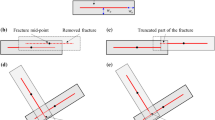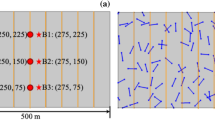Abstract
This research proposes a numerical scheme for evaluating the effect of cold-water injection into a geothermal reservoir. A fractional heat transfer equation (fHTE) is derived based on the fractional advection–dispersion equation (fADE) that describes non-Fickian dispersion in a fractured reservoir. Numerical simulations are conducted to examine the applicability of the fADE and the fHTE in interpreting tracer and thermal responses in a fault-related subsidiary structure associated with fractal geometry. A double-peak is exhibited when the surrounding rocks have a constant permeability. On the other hand, the peak in the tracer response gradually decreases when the permeability varies with distance from the fault zone according to a power law, which can be described by the fADE. The temperature decline is more gradual when the permeability of surrounding rocks varies spatially than when they have a constant permeability. The fHTE demonstrates good agreement with the temperature profiles for the different permeabilities of surrounding rocks. The retardation parameters in the fADE and the fHTE increase with the permeability of the surrounding rocks. The orders of the temporal fractional derivatives in the fADE and the fHTE vary with the permeability patterns.












Similar content being viewed by others
References
Aksoy N, Serpen U, Filiz Ş (2008) Management of the Balcova–Narlidere geothermal reservoir, Turkey. Geothermics 37(4):444–466
Axelsson G, Flovenz OG, Hauksdottir S, Hjartarson A, Liu J (2001) Analysis of tracer test data and injection induced cooling in the Laugaland geothermal field, N-Iceland. Geothermics 30:697–725
Benson DA, Wheatcraft SW, Meerschaert MM (2000) Application of a fractional advection–dispersion equation. Water Resour Res 36(6):1403–1412
Bodvarsson GS (1972) Thermal problems in siting of reinjection wells. Geothermics 1(2):63–66
Bodvarsson GS, Tsang CF (1982) Injection and thermal breakthrough in fractured geothermal reservoirs. J Geophys Res 87(B2):1031–1048
Carslaw HS, Jaeger JC (1959) Conduction of heat in solids, 2nd edn. Oxford Science Publications, Oxford
Coats KD, Smith BD (1964) Dead-end pore volume and dispersion in porous media. Soc Pet Eng 4:73–84
Evans JP, Forster CB, Goddard JV (1997) Permeability of fault-related rocks, and implications for hydraulic structure of fault zones. J Struct Geol 19(11):1393–1404
Fomin SA, Chugunov VA, Hashida T (2005) The effect of non-Fickian diffusion into surrounding rocks on contaminant transport in a fractured porous aquifer. Proc R Soc A Math Phys Sci 461:2923–2939
Fomin SA, Chugunov VA, Hashida T (2011) Non-Fickian mass transport in fractured porous media. Adv Water Resour 34(2):205–214
Gringarten AC, Sauty JP (1975) A theoretical study of heat extraction from aquifers with uniform regional flow. J Geophys Res 80(35):4956–4962
Le Garzic E, de L’Hamaide T, Diraison M, Geraud Y, Sausse J, de Urreiztieta M, Hauville B, Champanhet J (2011) Scaling and geometric properties of extensional fracture systems in the proterozoic basement of Yemen. Tectonic interpretation and fluid flow implications. J Struct Geol 33(4):519–536
Horne RN (1981) Tracer analysis of fractured geothermal systems. GRC Trans 5:291–294
Huang Q, Huang G, Zhang H (2008) A finite element solution for the fractional advection–dispersion equation. Adv Water Res 31(12):1578–1589
Kocabas I (2004) Geothermal reservoir characterization via thermal injection backflow and interwell tracer testing. Geothermics 34(1):27–46
Lauwerier HA (1955) The transport of heat in an oil layer caused by the injection of hot fluid. Appl Sci Res 5(2–3):145–150
Massart B, Paillet M, Henrion V, Sausse J, Dezayes C, Genter A, Bisset A (2010) Fracture characterization and stochastic modeling of the granitic basement in the HDR Soultz project (France). Proc World Geotherm Congr 1:1–7
Pruess K, Oldenburg C, Moridis G (1999) TOUGH2 user’s guide, version 2.0. LBL, Report, LBNL-43134
Samko SG, Kilbas AA, Marichev OI (1993) Fractional integrals and derivatives: theory and applications. Gordon and Breach, London
Savage H, Brodsky E (2011) Collateral damage: evolution with displacement of fracture distribution and secondary fault strands in fault damage zones. J Geophys Res 116(B3):B03405. doi:10.1029/2010JB007665
Shook GM (2001) Predicting thermal breakthrough in heterogeneous media from tracer tests. Geothermics 30(6):573–589
Suzuki A, Makita H, Niibori Y, Fomin SA, Chugunov VA, Hashida T (2012) Characterization of tracer responses using fractional derivative-based mathematical model and its application to prediction of mass transport in fractured reservoirs. GRC Trans 36:1391–1396
Welty J, Wicks CE, Rorrer GL, Wilson RE (2007) Fundamentals of momentum, heat and mass transfer, 5th edn. Wiley, New York
Woods AW, Fitzgerald SD (1993) The vaporization of a liquid front moving through a hot porous rock. J Fluid Mech 251:563–579
Xiao B, Yu B, Wang Z, Chen L (2009) A fractal model for heat transfer of nanofluids by convection in a pool. Phys Lett A 373(45):4178–4181
Zhang X, Lv M, Crawford JW, Young IM (2007) The impact of boundary on the fractional advection–dispersion equation for solute transport in soil: defining the fractional dispersive flux with the Caputo derivatives. Adv Water Resour 30(5):1205–1217
Acknowledgments
This work was supported by a Grant-in-Aid for the Japan Society for the Promotion of Science (Grant Number 23-3250).
Author information
Authors and Affiliations
Corresponding author
Rights and permissions
About this article
Cite this article
Suzuki, A., Niibori, Y., Fomin, S.A. et al. Analysis of Water Injection in Fractured Reservoirs Using a Fractional-Derivative-Based Mass and Heat Transfer Model. Math Geosci 47, 31–49 (2015). https://doi.org/10.1007/s11004-014-9522-5
Received:
Accepted:
Published:
Issue Date:
DOI: https://doi.org/10.1007/s11004-014-9522-5




